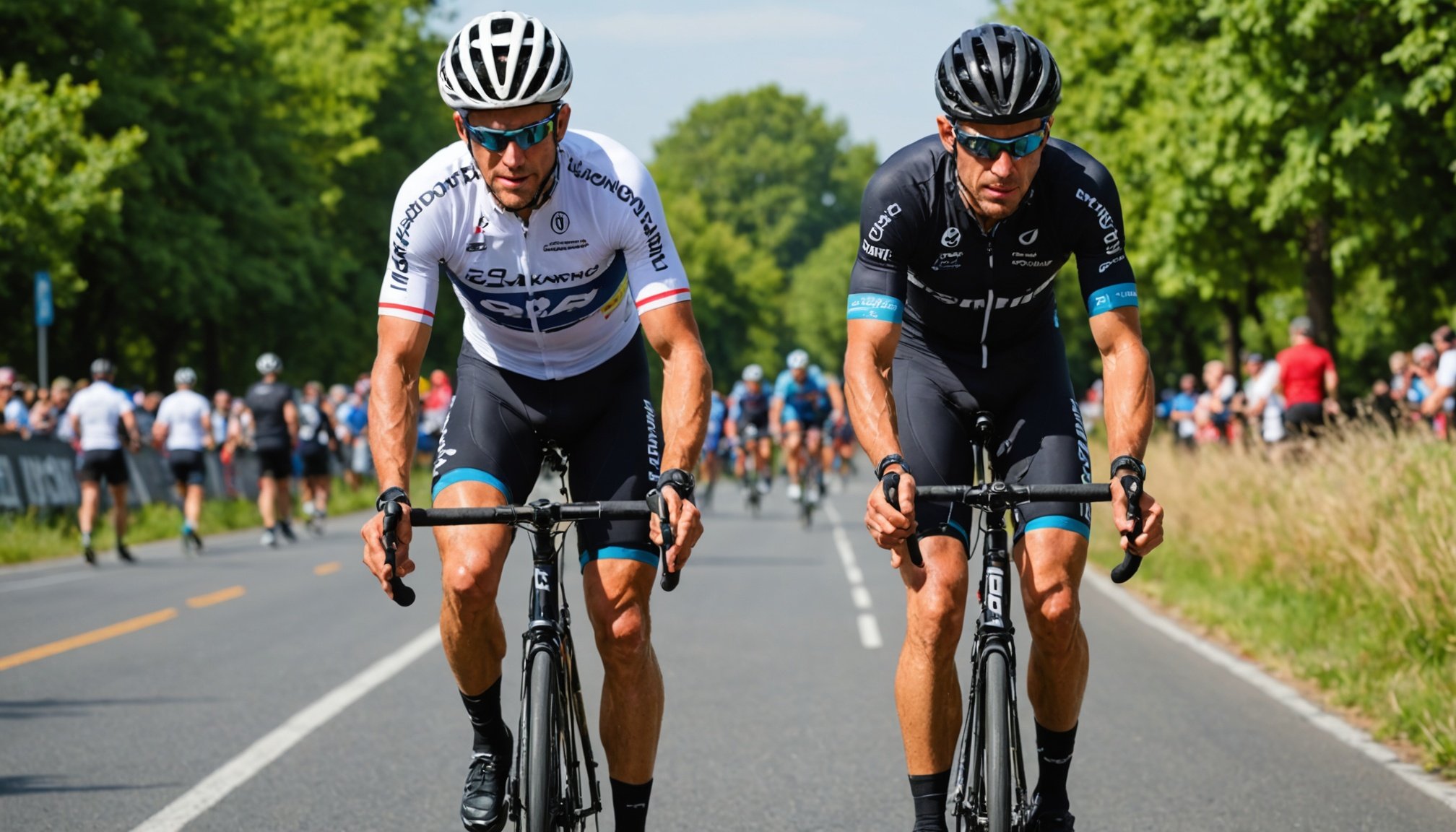Advanced Endurance Training Techniques
When it comes to endurance training for cycling, a strong aerobic base is first on the checklist. Cyclists must develop their aerobic system to sustain energy over long distances. This involves building endurance through low-intensity, long-duration rides, which trains the body to utilise oxygen efficiently and delay fatigue.
Next, specific interval training methods boost endurance further. Interval training involves short, intense bursts of exercise followed by recovery periods. These intervals enhance a cyclist’s aerobic capacity and raise the lactate threshold, allowing them to maintain a higher pace over long distances. For instance, intervals of high-intensity cycling followed by short rest periods become crucial in a multi-stage competition setting.
Also to see : Elevate your equestrian game: expert tips to master jumping skills and maximize your scores
Moreover, the often-overlooked yet vital role of strength training cannot be understated in cycling. Including strength exercises, like squats and lunges, builds the muscle power needed for challenging terrains and sprints during competitions. Strength workouts contribute significantly to increasing pedal force and reducing the risk of injury.
In conclusion, combining a solid aerobic base, strategic interval training, and targeted strength workouts results in an effective endurance training regimen, turning the cyclist into a formidable competitor in any multi-stage competition.
Also to see : Achieving tranquility before the glide: key techniques for ice skaters to manage nerves and enhance performance
Nutrition Strategies for Endurance Cyclists
Understanding the importance of fueling strategies is essential for any endurance cyclist. Carefully planned cycling nutrition helps sustain energy levels and enhances overall performance. It is crucial to tailor your nutrition plan to align with your specific cycling needs to harness optimum endurance benefits.
Macronutrient Ratios for Optimal Performance
For an endurance cyclist, a balanced intake of carbohydrates, proteins, and fats is vital. Carbohydrates serve as the primary energy source. Typically, 60-70% of your daily calorie intake should come from carbohydrates to ensure sufficient glycogen storage. Proteins are crucial for muscle repair, accounting for about 15-20% of calorie intake, while fats are essential for sustained energy, comprising the remaining 10-15%. This macronutrient distribution is vital to maximise endurance benefits.
Hydration Techniques for Long Rides
Hydration is as crucial as proper nutrition during long rides. Effective hydration techniques involve consuming water consistently and incorporating electrolyte-rich beverages to replace lost salts. The goal is to prevent dehydration without overhydrating, which can lead to hyponatremia. For rides over 60 minutes, aim for at least 500 to 700ml of fluid per hour, adjusting based on sweat rate and weather conditions.
Recovery Techniques to Enhance Performance
Effective recovery strategies play a crucial role in optimizing performance for endurance cyclists. Balancing intense training sessions with proper recovery ensures the body can adapt and improve.
Benefits of Active Recovery
Active recovery helps to reduce fatigue by encouraging blood circulation and the removal of metabolic waste. Incorporating low-intensity exercises, such as leisurely cycling or jogging, can enhance recovery without completely halting physical activity. This method helps to maintain flexibility and prevent stiffness.
Importance of Sleep
A focus on adequate sleep can significantly impact endurance cycling recovery. Sleep supports muscle repair, memory consolidation, and hormone regulation. Prioritizing quality sleep not only improves overall health but also boosts performance capabilities by ensuring the body is adequately rested.
Techniques like Foam Rolling and Stretching
Incorporating foam rolling and stretching into your routine can further aid in recovery. Foam rolling assists in releasing muscle tightness and improving blood flow, while stretching enhances flexibility and range of motion. These methods help prevent injuries and support long-term performance by maintaining muscle health and elasticity.
The Role of Periodization in Training
Periodization plays a pivotal role in structuring effective training programs. It ensures that athletes are optimally prepared for competitions and can reach their peak performance when it matters most.
Understanding Training Phases and Goals
Training periodization divides the training process into distinct phases, each with specific goals. These phases often include preparation, competition, and transition periods. During the preparation phase, athletes focus on building a solid foundation, which might emphasize strength and endurance. As the competition approaches, the focus shifts to sport-specific skills and refining techniques. Finally, the transition phase allows for recovery and assessment before starting another cycle.
Adjusting Training for Different Stages of Competitions
Adaptability is crucial, as different competitions may require varied approaches in training cycles. For instance, early-season competitions might see athletes in a build phase, while peak events demand tapering strategies. Tapering involves reducing training intensity, allowing athletes to perform at their best during crucial moments.
Monitoring Progress and Making Adjustments
Monitoring progress is essential for refining future cycles. Using performance data, athletes can make informed adjustments to their routines, enabling continuous improvement. This data-driven approach not only enhances preparation but also ensures that each training periodization cycle is more effective than the last. Each element in periodization contributes to a cohesive and successful training strategy.
Testimonials and Insights from Experienced Cyclists
Cyclist testimonials provide invaluable insights into the realities faced by those committed to the sport. Real-world experiences shared by accomplished cyclists reveal a wealth of knowledge on training methods and overcoming obstacles encountered during gruelling competitions. Experienced insights highlight the necessity of tailored preparation tailored for multi-stage events.
A seasoned cyclist may emphasise the importance of consistent training and strategic rest periods to optimise performance. Various training regimens might involve interval work and endurance rides that vary in intensity and duration, according to athlete-specific goals. Multi-stage tips often explore nutritional strategies, hydration, and mental preparation essential for stamina.
The challenge of maintaining physical and psychological resilience throughout intensively demanding stages is a common concern. To combat fatigue and sustain peak performance, advice from veteran cyclists includes monitoring progress diligently and adjusting tactics when necessary.
Endurance techniques are enhanced by incorporating feedback from mentors and peers, who have confronted similar tests. By learning from those who have successfully navigated complex racing landscapes, upcoming cyclists grow equipped with tried-and-true strategies designed for success. Such guidance paves the way for tackling the multifaceted nature of competitive cycling more effectively.











